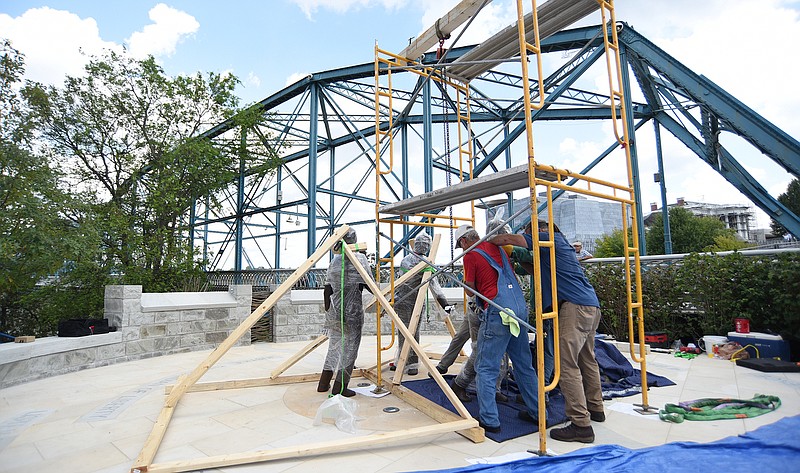What has been so wrongheaded with the removal of Confederate statues in cities across the South over the past several years is the useless attempt to whitewash history.
Whether or not we want to admit it, the country's internal struggle over slavery played out in our region 160 years ago. States seceded from the union. A war was fought. Tens of thousands died. Slaves were freed. The country reunited.
As we have often suggested, the best way for Southern cities to illustrate these complex stories is to provide perspective. Don't remove that statue of Robert E. Lee. Place a sign by it with more context. Or erect a statue beside it of abolitionists Harriet Tubman or Sojourner Truth or a modern civil rights leader.
But for many places, that time is past. What's done is done. The attempt to erase history has occurred.
In Chattanooga, though, a historic bridge will feature the type of perspective we have in mind.
On March 19, 1906, a Black man named Ed Johnson was lynched on the Walnut Street Bridge for a reported assault on a white woman earlier that year. Not only was there no evidence linking him to the crime, of which he was nevertheless found guilty, but the United States Supreme Court only the day before had issued a stay of execution so the full court could hear his case.
Instead, a mob broke Johnson out of jail, took him to the bridge and hanged him from the second span, his last words, "God bless you all; I am innocent" echoing in their ears.
This weekend, a permanent art installation that features Johnson, and his brave Black lawyers, Styles Hutchins and Noah Parden, will be unveiled at the south end of the bridge, the end closest to where he was hanged (and, to be sure he was dead, cruelly shot numerous times).
The work also will pay tribute to another Black man, Alfred Blount, lynched on the bridge in 1893, and two other men who were lynched in the county.
For some citizens of Chattanooga, the Walnut Street Bridge - since the 1999 publication of "Contempt of Court," a book about the Johnson lynching - has been a reminder of what occurred there, and therefore was purposefully off-limits for them.
"I had declared that I would never walk on that bridge again," then-Hamilton County Commissioner Greg Beck said at a 2016 ceremony celebrating a state resolution that acknowledged the lynching and the lack of evidence in the case, "because it seemed that nobody cared about what happened there."
The bridge by that time had become an iconic Chattanooga landmark. Built in 1890, it was closed to vehicle traffic in 1978 and sat in disrepair for nearly a decade. However, several Chattanoogans had the idea to convert it to a pedestrian walkway, and it opened as such in 1993.
It was added to the National Register of Historic Places in 1990, is today called one of the world's longest pedestrian bridges and also has been tabbed as one of the 10 most beautiful open spaces in the country.
After this weekend, the bridge will have the perspective it lacked. It still will be a place where Chattanoogans enjoy a stroll across the Tennessee River, but a striking art installation at one end will remind those who take the span for granted what also happened there.
What made the crime even more shocking was that it did not take place on some lone tree out in the faraway countryside. It occurred on a busy city thoroughfare. Accounts in the next morning's Chattanooga Daily Times described the milieu in which it occurred.
Streetcars were running, and the mob holding Johnson commanded them to stop and to turn off their headlights. After the group had hanged and shot Johnson and left, a white woman and her husband left her streetcar to take a look. A Black woman who was unaware of what had happened then came upon the scene and asked, "Is he dead, white folks?" Told he was, she said, "Well, I swan," and walked the rest of the way across the bridge.
At least half a dozen or more women, the paper reported, came within 15 or 20 feet to have a look. Although his killers moved him off the streetcar tracks where he dropped, he lay on the bridge for an hour before a "dead wagon came to the bridge and took the remains" to a morgue.
The newspaper editorialized that the city was "shamed and humiliated" over what took place. "[I]f something is not done to stay the growth of that [mob] spirit, who shall say it will not be upon us full before we know it? ... It is a time ... to take council together and see if something may not be done to check this evil."
The next day, though, the newspaper advised Blacks that "the quicker and more obediently they accept the situation [of letting the law handle the situation] the better it will be for all concerned."
That would be the white community's response to Black injustices for more than another half century. The civil rights movement changed some things. Now, another 50 years later, at least one community sees the wisdom in applying proper perspective to history.
We hope it becomes a growing trend.
